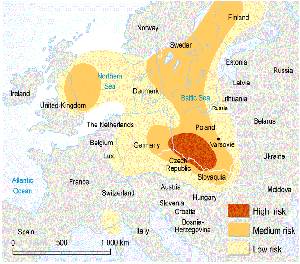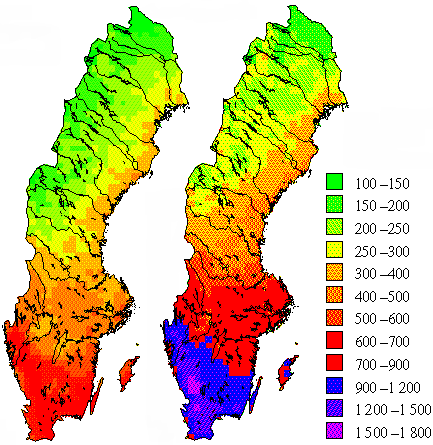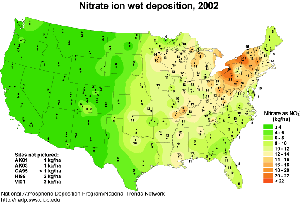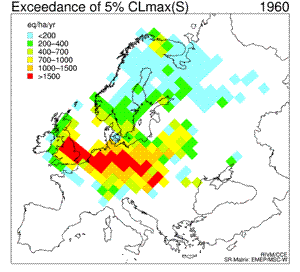 > ENC Master > Climate Encyclopaedia > Climate in Cities > basics > 3. Acid Rain > - Areas in danger
> ENC Master > Climate Encyclopaedia > Climate in Cities > basics > 3. Acid Rain > - Areas in danger
 |
|
|
|
Climate in citiesBasics |
Areas endangered by acid rainsAcid rains occur mainly in the highly industrialized regions where the emissions of SO2 and NOx are large. However, due to transportation by winds, they may affect areas located thousands kilometres away from the emittors.
|
|
Endangered regions
The areas most endangered by acid rains are those where the acid rocks can be found on the surface, where precipitation is rather high, and where there are many sources of SO2 and NOx emissions. The increasing demand for electricity and the rise in the number of motor vehicles in recent decades has meant that emissions of acidifying pollutants have increased dramatically from human sources, particularly since the 1950s (read also about natural emissions of SO2 and NOx).
|
|
Europe Most endangered is northern and central Europe. The pollutants' emissions are heavily concentrated in the industrial areas. As a result, precipitation is generally acidic in these regions (pH 4.1 to pH 5.1). The comparison of Figures 1 and 2 shows that Scandinavian countries are endangered by acid rains even though there are no large emission sources of SO2 there. |
In Scandinavia, the acidity and pollutant content of precipitation are greatest in the southern parts of Sweden. Deposition of acidifying substances is determined, however, not only by the acidity of precipitation but also by precipitation quantities. Consequently the heaviest acid deposition in Sweden affects the precipitation-rich parts of south-west Sweden. |
|
North America Most endangered are highly urbanised and industrialised regions of eastern Canada and north-eastern USA. Sources of SO2 in the USA are concentrated in Ohio, Indiana and Illinois, and prevailing winds carry it to New England and Canada. Figures 4 and 5 show areas with the highest deposition of acidifying substances. The areas that combine acid rain and little neutralising capacity are located at high elevations east of the Mississippi. |
|
|
Major problems to aquatic life from acidic rain include e.g. loss of Atlantic salmon in Nova Scotia and Maine and reduction in fish diversity in northwest Pennsylvania. 41% of lakes in the Adirondack region of New York are either chronically or episodically acidic. In Canada, acid rain has resulted in large losses of fish and aquatic communities in over 30,000 sensitive lakes in Ontario and Quebec. |
|
Asia Acid rain is now emerging as a major problem in the developing world, especially in parts of Asia and the Pacific region where energy use has surged and the use of sulfur-containing coal and oil is very high. China and India have become endangered in the mid-1970s, when the industry development was most intensive there. An estimated 34 million metric tons of SO2 were emitted in the Asia region in 1990, over 40% than in North America. Acid deposition levels were particularly high in areas such as southeast China, northeast India, Thailand, and the Republic of Korea, which are near or downwind from major urban and industrial centers. The effects are already being felt in the agriculture sector. Researchers in India found that wheat growing near a power plant where SO2 deposition was almost five times greater than the critical load (about critical load see the section below) suffered a 49% reduction in yield compared with wheat growing 22 kilometers away. In southwestern China, a study in Guizhou and Sichuan provinces revealed that acid rain fell on some two thirds of the agricultural lands, with 16 percent of the crop area sustaining some level of damage. A study of pines and oaks in acid rain-affected areas of the Republic of Korea, both rural and urban, showed significant declines in growth rates since 1970. Negative effects of acid rains have been also observed in Brazil and Venezuela.
|
|
Critical loads and target loads
|
|
Critical loads are the maximum amount of pollutants that ecosystems can tolerate without being damaged, the amount that will not cause chemical changes leading to long-term harmful effects in the most sensitive ecological systems. In order to obtain values for the critical loads, an ecosystem has to be chosen and then a suitable indicator species is selected to represent the ecosystem. A chemical limit is subsequently defined as the concentration at which the indicator species will die. In forests the indicators are trees, and in freshwaters they are fish. |
|
In 1990, around 93 million hectares of natural environment in Europe were affected by acid deposition that exceeded the critical load. In order to achieve the desired limits it will be necessary to reduce acidifying pollution in parts of Europe by 80-90% compared with 1990 levels.
|
|
Related pages: You will learn about acid rain origin in:
|
|






